A Note on R. Bezalel Alexandrov’s משכן בצלאל and its Prenumeranten
A Note on R. Bezalel Alexandrov’s משכן בצלאל and its Prenumeranten
By Shnayer Z. Leiman
Not much appears to be known about R. Bezalel Alexandrov (circa 1850-1930). Born in Grodno, he would ultimately come under the influence of the teachings of R. Yisrael Salanter (1809-1883), largely through the efforts of R. Yitzchak Blazer, i.e., R. Itzel Peterburger (1837-1907). R. Bezalel considered R. Itzel to be his primary teacher, especially during the period they both resided in Kovno. R. Bezalel was a close associate of R. Yosef Yozel Horowitz (1847-1919) of Nevarodok, perhaps the last of the disciples of R. Yisrael Salanter. A musar enthusiast, R. Bezalel served as a moreh zedek (i.e., a dayyan) in Minsk, where he also founded a kibbutz (a kind of kollel for advanced – and mostly married — students) in the Minsk suburb of Kamerovka.[1]
R. Bezalel published two books in his lifetime, משכן בצלאל (Vilna, 1923) and ילקוט בצלאל (Piotrkow, 1927-9). Both are significant, rarely seen, and often miscatalogued by the few bibliographers who managed to hold copies in their hands. Here, we shall focus primarily on משכן בצלאל.
מפעל הביבליוגרפיה lists only part 1 of משכן בצלאל, with 40 pages. Doubtless, מפעל הביבליוגרפיה’s bibliographer recorded exactly what he saw, a bound volume with 40 pages. But, in fact, aside from the 40 page edition, an edition including parts 1 and 2, and totaling 136 pages, was published in a bound volume, also in Vilna, 1923.[2] The book is largely a polemic against young Jewish men who insist on postponing marriage beyond the age of 20.[3] R. Bezalel’s second book, ילקוט בצלאל expands the polemic to other public manifestations of disregard for the rules of the Shulhan Arukh , such as the disregard of the mitzvot of ציצית, תפילין, מזוזה, and Sabbath observance.[4] In brief, R. Bezalel was a musarnik who was addressing the Jewish confrontation with modernity in Lita. At one point in his writings, he summarizes the confrontation as follows:[5]
Even aside from their general content, משכן בצלאל and its companion volume ילקוט בצלאל are of special interest for three reasons:
1. They were accorded a letter of approbation from R. Yisrael Meir Ha-Kohen, the חפץ חיים.[6]
For the most part, the חפץ חיים wrote הסכמות with the greatest of reluctance. Generally, he refrained from writing הסכמות, offering a wide range of excuses why he could not do so. These included: he was not worthy to do so; he had not the time to do so; his failing eyesight and old age made it difficult to do so; he feared that by acquiescing to one request, he would be inundated with requests from others; and – most importantly – he had resolved long ago not to write הסכמות. After offering one or the other of these excuses, he would invariably close his letter with words of blessing and encouragement for the author – without a word said about the quality of the book. Nonetheless, it cannot be denied that the חפץ חיים did write a handful of genuinely enthusiastic הסכמות where he praised the books themselves.[7]
It is difficult to categorize the הסכמה written by the חפץ חיים for R. Bezalel Alexandrov’s משכן בצלאל. Not a word is said about the content of the book, but much is said about the author. Moreover, the חפץ חיים offers his blessing to all who come to the aid of the author. In context, this clearly means a blessing to all who buy a copy of his book.[8] Indeed, the חפץ חיים himself is listed as the first subscriber to the book (see below, item 3)! Nevertheless, the sense one has from reading the הסכמה is that it was an act of חסד by the חפץ חיים, rallying to the aid of a colleague in need.
2. They record teachings of R. Itzel Peterburger (and other musarniks, such as R. Yisrael Horodner, the Maggid of Minsk[9]) not recorded elsewhere.
Here, one sample will suffice. Although we have many accounts of R. Itzel Peterburger’s “vow of silence” during the 40 day period from Rosh Hodesh Elul through Yom Kippur,[10] R. Bezalel’s account offers details not recorded elsewhere:[11]
3. A lengthy list of subscribers is appended to משכן בצלאל that sheds light on the history of Vilna’s kloyzen.[12]
Lists of subscribers, known as prenumeranten,[13] are significant for a variety of reasons. Often, they tell us how far and wide authors traveled in order to raise the funds necessary for the publication of their books. They tell us who bought the books, and when and where they were purchased. Our list is particularly significant because it is mostly kloyzen driven, i.e., the books were acquired for the libraries of the various synagogues, בתי מדרשים, and kloyzen in Vilna. Indeed, our list includes several kloyzen not listed in the most recent and most comprehensive list of Vilna kloyzen published in 2012![14] Our list also lists key members of the various kloyzen in 1923. There are more such lists of Vilna subscribers and their kloyzen, and they all need to be examined.[15]
Notice that our list includes among the subscribers the חפץ חיים, R. Chaim Ozer Grodzenski, R. Menachem Krakowski (maggid mesharim of Vilna), and R. Boruch Ber Leibowitz (then serving as Rosh Yeshiva of Yeshivas Kneses Beis Yitzchak in Vilna, and as a moreh zedek in Vilna). Each is accorded the title הגאון הגדול. Also among the subscribers (fourth on the list) is R. Isaac Rubinstein, listed is the רב מטעם, i.e., “the crown rabbi.” It is surely no accident that he is listed as הגאון, but not as הגאון הגדול. He was a distinguished – and tragic – rabbinic figure,[16] and it seems quite clear that R. Bezalel Alexandrov wanted to make a distinction between the various rabbis listed as subscribers.
In sum, the list reproduced here serves as a reminder to scholars that it is not enough to examine archival lists and history books. One often needs to examine other kinds of evidence – such as prenumeranten – that shed much light on Jewish social and intellectual history.[17]
Notes:
[1] See S. Even-Shoshan, ed., מינסק עיר ואם (Tel-Aviv, 1975), vol. 1, pp. 99-100. Cf. S. Weintraub, נובהרדוק (Bnei Brak, 2014), vol. 1, pp. 255- 257.
[2] A copy of the 136-page edition is available at the Mendel Gottesman Library of Yeshiva University. Neither the 40-page edition nor the 136 page edition is available online on HebrewBooks.org, אוצר החכמה, and אוצרות התורה.
[3] In general, see the sources cited in S. Stampfer, “Marital Patterns in Interwar Poland,” in Y. Gutman, ed., The Jews of Poland Between Two World Wars (Hanover, 1989), pp. 173-197. Cf. his “The Social Implications of Very Early Marriage,” in S. Stampfer, Families, Rabbis and Education (Oxford, 2010), pp. 7-25. None of the social historians seem to have been aware of משכן בצלאל.
[4] ילקוט בצלאל consists of two parts, the first contains 86 pages, and the second contains 102 pages. Part 1 is available online on Hebrew Books and אוצר החכמה, but not on אוצרות התורה. Part 2 is not available online. A copy with parts 1 and 2 is available at the National Library in Jerusalem.
[5] ילקוט בצלאל, part 1, p. 71.
[6] The letter of approbation was designated for משכן בצלאל, where it first appeared. The author took the liberty of reprinting it (together with two other letters of approbation that first appeared in משכן בצלאל) in his ילקוט בצלאל.
[7] See מאיר עיני ישראל (Bnei Brak, 2003), vol. 6, pp. 782-801.
[8] So, apparently, it was understood by R. Bezalel Alexandrov himself. See משכן בצלאל, p. 2.
[9] See, e.g., משכן בצלאל, p. 66. On R. Yisrael, see M. Heilprin,הגדול ממינסק (Jerusalem, 1994), pp. 96, 121-122, and 201.
[10] See, e.g., D. Katz, תנועת המוסר (Tel-Aviv, 1954), vol. 2, pp. 232-235; Ch. E. Zaichyk, המאורות הגדולים (Brooklyn, 1953), pp. 149-165; and M. Blazer, רבי איצלה (Bnei Brak, 2014), pp.475-540. None stresses the fact that R. Itzel, aside from his frequent hortatory Musar talks throughout Yom Kippur eve and day, also led the Kol Nidrei, Musaf, and Nei’lah services! It may well be that R. Itzel didn’t do this ordinarily on Yom Kippur (or in his old age), but R. Bezalel offers eyewitness testimony to what he experienced as a youth in Kovno.
[11] ילקוט בצלאל, pp. 31-32. A lengthy דבר תורה by R. Itzel follows the passage excerpted here.
[12] On Vilna’s kloyzen, see in general Khaykl Lunski, מהגיטו הוילנאי (Vilna, 1921), pp. 48-65, and the much fuller and more comprehensive listing of 135 (and more) kloyzen in A. Cohen-Mushlin et al, eds., Synagogues in Lithuania N-Z (Vilnius, 2012), pp. 281-353.
[13] On prenumeranten, see Berl Kagan, ספר הפרענומעראנטן [Hebrew Subscription Lists], New York, 1975; Shlomo Katzav, ספר החותמים (Petah Tikvah, 1984), vol. 2; and idem, ספר החותמים (Petah Tikvah, 1992), vol. 3. [See the late Tovia Preschel’s review of Berl Kagan’s ספר הפרענומעראנטן in the Jewish Press, May 30, 1975, p. 40; I am indebted to Menachem Butler for bringing the review to my attention. More importantly, see the recently published מאמרי טוביה, vol. 1 (Jerusalem, 2016) for a treasure trove of reviews and essays by Tovia Preschel, bibliophile and bibliographer par excellence. No Judaica library – public or private – should be without this volume, and without the full set when brought to completion.] These volumes provide indices to all Hebrew books that include prenumeranten by listing alphabetically all the towns and cities where the authors solicited subscriptions. Under each place listed, appear the titles of all Hebrew books that include subscribers from that place. Thus, if your great-grandfather was from Jaroslaw in southeastern Poland, you would locate the entry “Jaroslaw” in the Kagan or Katzav volumes, and immediately see the appended list of Hebrew books that include prenumeranten from Jaroslaw. You would then have to examine (online or at the library of your choice) each of the titles listed to see if your great-grandfather’s name appears on its list of prenumeranten. Cf. below, note 17.
[14] Cf. above, note 12. Thus, for example, בהמ”ד חורשי עצים, בהמ”ד קו”ק, and בהמ”ד פועלי צדק are either not mentioned or not properly identified in Synagogues in Lithuania. בהמ”ד שומר אמונים is mentioned in Synagogues in Lithuania (p. 340) but not identified.
[15] See, e.g., the highly informative list of prenumeranten and kloyzen in Vilna in R. Ch. S. Gluskin, רחשי לב (Bilgoray, 1934), pp. 271-272.
[16] On Rabbi Rubinstein, see G. Bacon, “Rubinstein vs. Grodzinski: The Dispute Over the Vilnius Rabbinate and the Religious Realignment of Vilnius Jewry 1928-1932,” in I. Lempertas and L. Lempertiene, eds., The Gaon of Vilnius and the Annals of Jewish Culture (Vilnius, 1998), pp. 295-304, and the references cited in Bacon’s note 4.
[17] It is with great joy and much anticipation that we welcome the recent publication of the first volume of קונטרס שמות החותמים (Brooklyn, 2016).
Unlike the indices listed above in note 12, it reproduces the full lists of prenumeranten exactly as they appeared when first printed. The volume contains 670 pages of prenumeranten from lists that appeared in books printed between 1790 and 1840. Presumably, the volumes to follow will print all lists from 1840 through the mid 20th century, when such lists mostly fell into desuetude. If brought to fruition, the entire set will probably consist of four volumes. The advantage of the קונטרס שמות החותמים volumes, of course, is that here we have the names of all the subscribers before our very eyes. The first volume is surely a gold mine of information, but questions remain. Lacking an introduction, we are not informed who is really responsible for the volume; what are its goals; whether or not there will be a full index of titles, names, and places; which libraries are providing the material that is being scanned; and which books are being included and which are being excluded. It seems obvious that either all or most of the books scanned by קונטרס שמות החותמים are from the Lubavitch Library in Brooklyn, certainly one of the world’s greatest collections of Judaica. But no single Judaica collection (not even the National Library in Israel) has copies of every Hebrew (and Yiddish) book. Any project attempting to gather all lists of prenumeranten will, by definition, have to be a universal project, involving the great Judaica libraries the world over. It is, for example, unclear, why the first list of prenumeranten in קונטרס שמות החותמים is from 1790, when such lists were quite common throughout much of the last quarter of the 18th century (e.g., יסוד עולם, Berlin, 1777; שבילי דרקיע, Prague, 1784). Despite these misgivings, קונטרס שמות החותמים is certainly a welcome addition to every Jewish bibliophile’s bookshelf. What ultimately needs to be done is to have all the lists of prenumeranten gathered together in one place, digitized and OCRed, so that the information contained in them (especially names of persons, names of towns and cities, and dates and places of publication) becomes searchable and retrievable. The yield for תלמידי חכמים, social historians, genealogists, and linguists (spelling of Hebrew and Yiddish names and places, history of surnames) is inestimable.
As a sample of some of the treasures that one can find in the new volume, we reproduce the title page of R. David Friesenhausen’s מוסדות תבל (Vienna, 1820), and two of its 14 pages of prenumeranten. These appear on pp. 331, 332, and 345-346 in קונטרס שמות החותמים. [ We have reproduced the pages from the original Vienna, 1820 edition, since the editor of קונטרס שמות החותמים sometimes divides a single page into two parts, presenting them as two pages.]
It will be noticed that the opening page of the prenumeranten lists the
ישמח משה, R. Moshe Teitelbaum (d. 1841) of Ujhely as one of the subscribers to מוסדות תבל. A later page of the prenumeranten lists the חתם סופר, R. Moshe Sofer (d. 1839) of Pressburg as a subscriber to מוסדות תבל. The appearance of these two distinguished names (and there are more) – arguably the two greatest rabbinic leaders of Hungarian Jewry – on the same list of prenumeranten surely attests to the reputation of the author of מוסדות תבל in 1820. On R. David Friesenhausen, an early advocate of the Copernican theory, see my introductory note to the late Chaim Reich’s reissue of מוסדות תבל (Brooklyn, 1997), and the fuller discussion, with references, entitled “R. David Friesenhausen: Precursor of Torah and Derekh Eretz,” in Jacob J. Schacter, ed., Judaism’s Encounter with Other Cultures (Northvale, 1997), pp. 158-164. See also the bibliographical note in Eliezer Brodt, “יחסה של הספרות היהודית לקופרניקוס במשך הדורות,” Hakirah 13 (Spring 2012), Hebrew section, p. 17, n. 33; and Jeremy Brown, “Rabbi David Friesenhausen’s Zemirah for the Solar System,” Hakirah 14 (Winter 2012), pp. 249-271. I am deeply grateful to Eliezer Brodt for bringing these references to my attention. The haunting account in David Schoen’s שוחרי השם בהרי הקרפטים (Jerusalem, 2005), pp. 43-50, is embedded in a historical novel, and cannot be accorded more esteem and historicity than the esteem and historicity accorded to the best of historical novels. They remain novels.
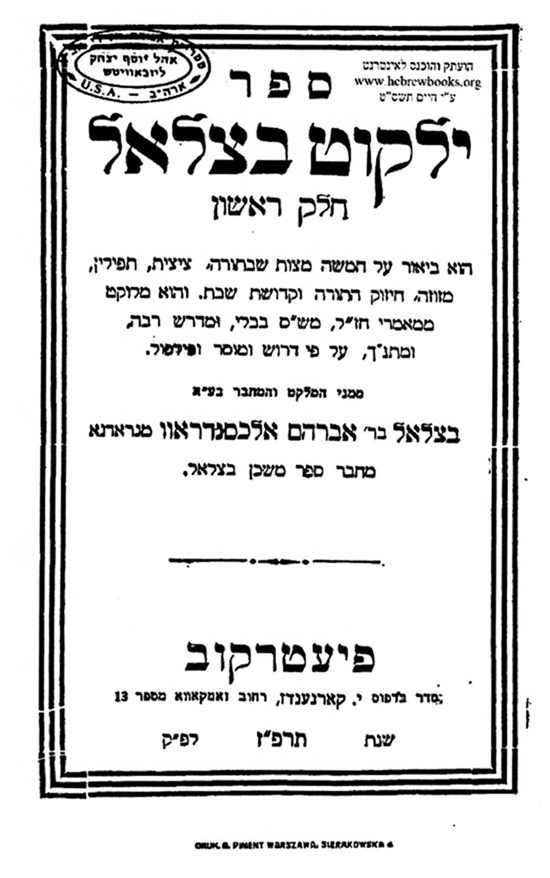


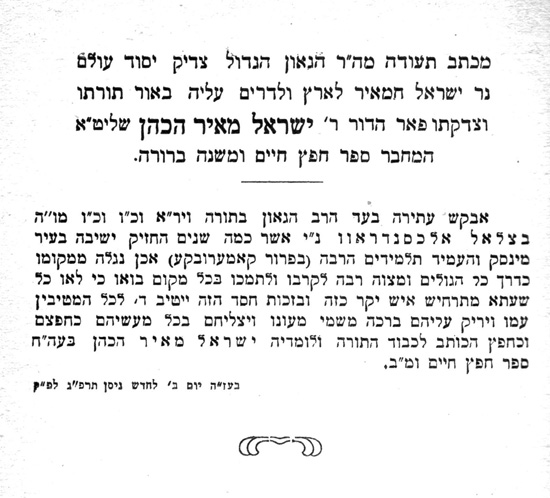
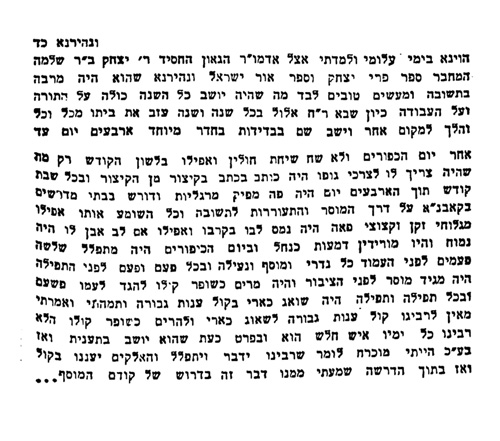
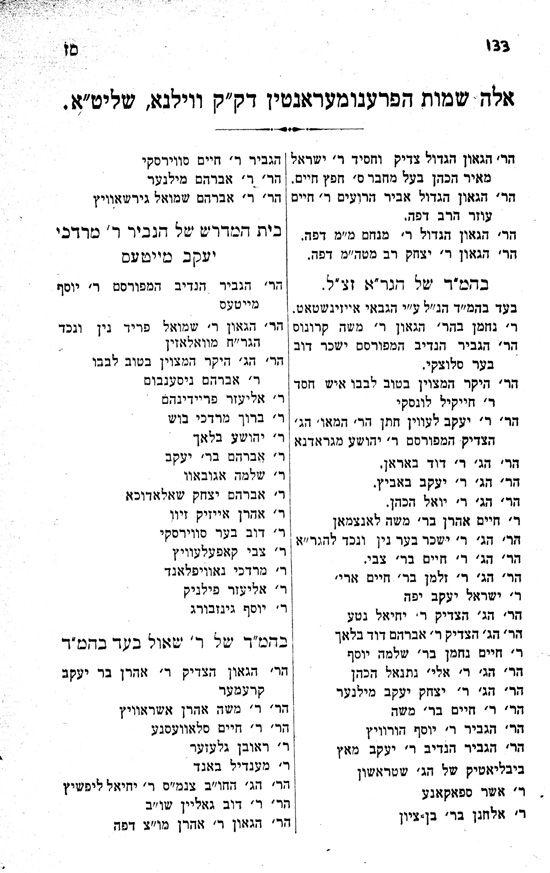
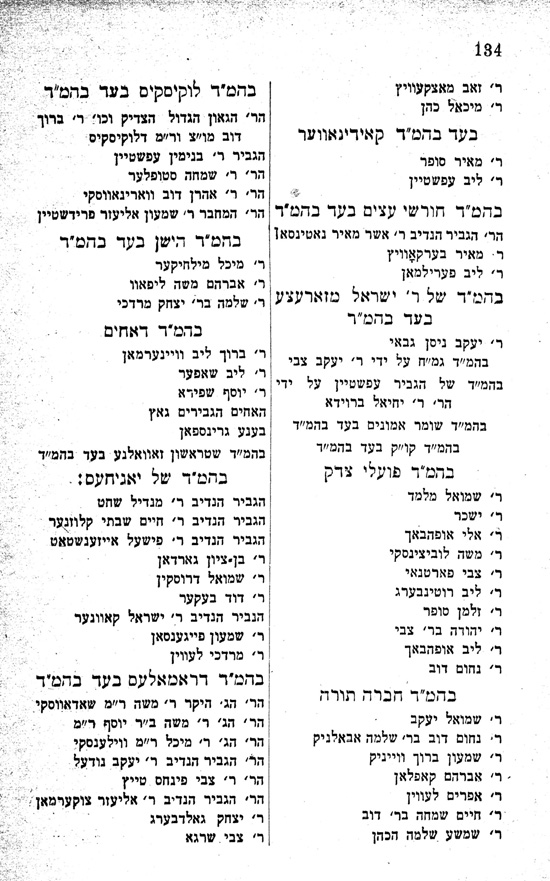
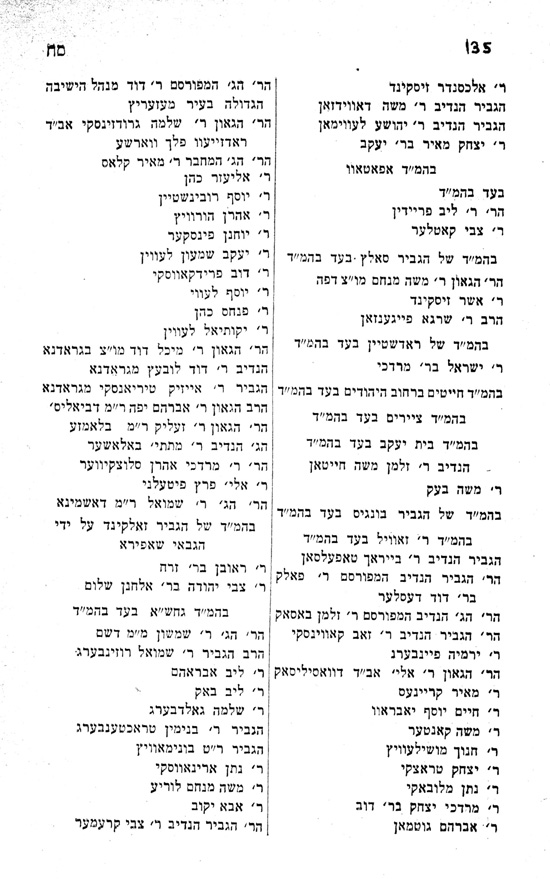
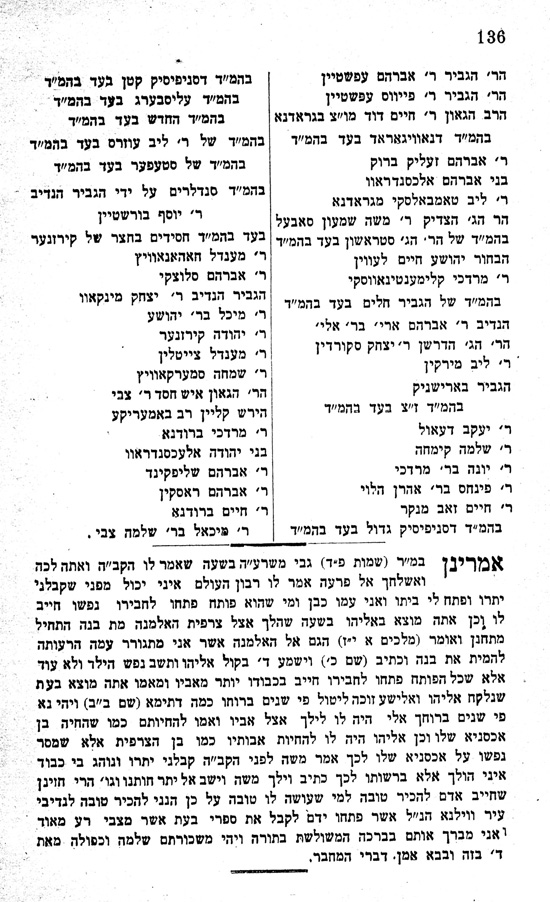
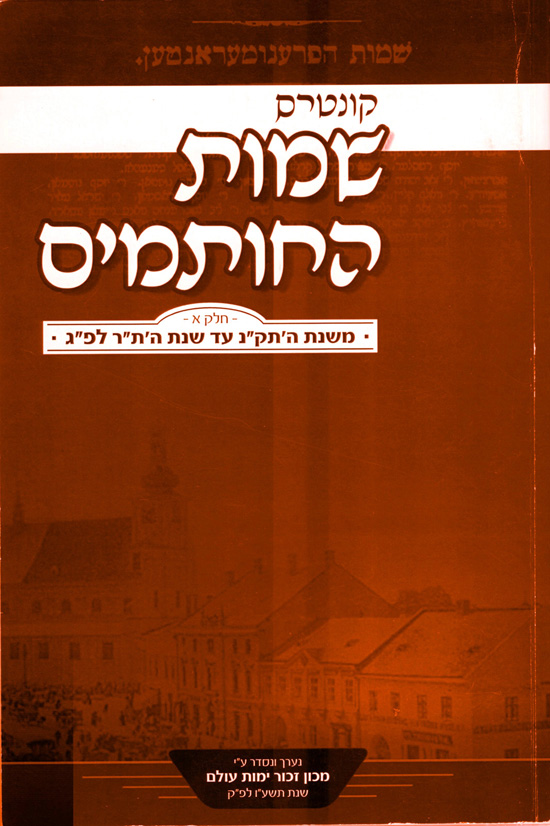
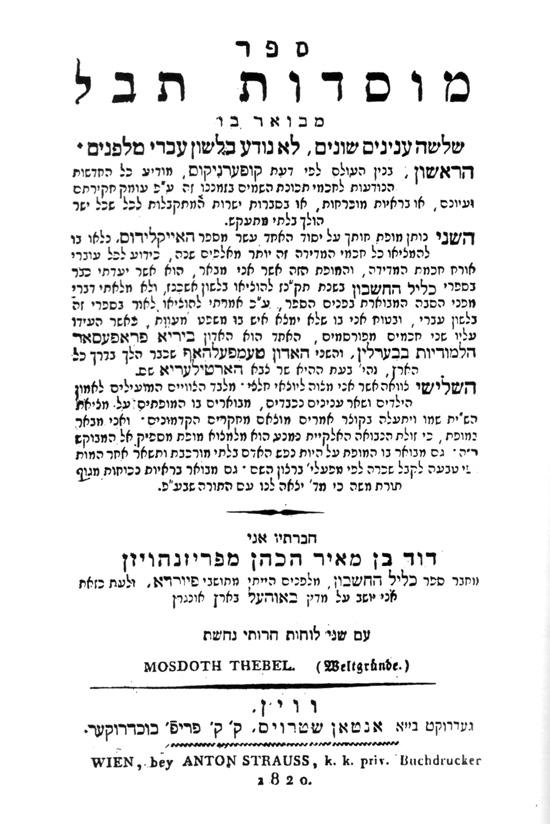
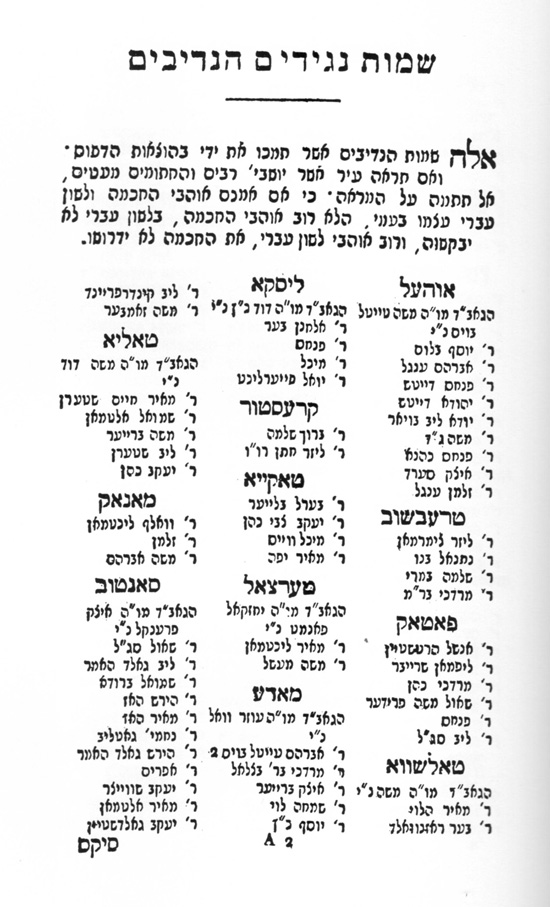
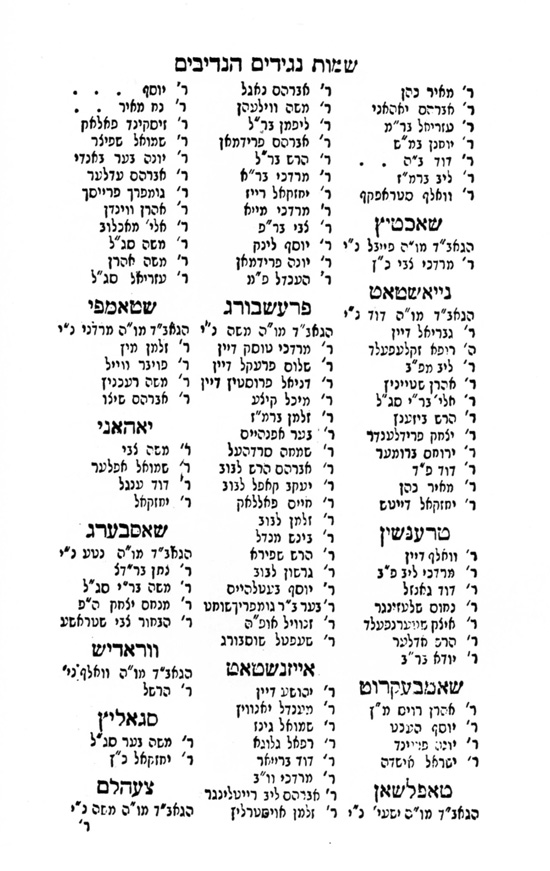



2 thoughts on “A Note on R. Bezalel Alexandrov’s משכן בצלאל and its Prenumeranten”
החידוש בדמי קדימה של הישמח משה, הוא פלאי במיוחד, הרי בסוף הספר ר' דוד משמיץ אותו בגסות ובביטול תורה והפיכת העיר למושב לצים, בה בשעה שישבו יחד באותו בית-דין. ולכן תרומת דמי-הקדימה היא מוזרה ביותר
Hello,
I have searched for years for information about my 4th Great-Grandfather, who was the Maggid mentioned here, Rabbi Yisrael Israelit of Grodno and then Minsk.
The author has a copy of the book he is mentioned in, by Rabbi M. Heilperin, reference #9. I cannot find a copy of this text and must assume it is out of print as I have been seeking it for years.
If anyone knows more about this book and can help me obtain copies or photographs of pages mentioned Rabbi Yisrael, you would not know how grateful I would be; I want to know more about him. The only thing I do know is that his daughter was named Sora, and she married my 3rd Great-Grandfather, who was a Rabbi as well, and then several of his children came to the United States. They knew their grandfather, Yisrael, and mentioned him many times. The family has been almost lost, and I am determined to maintain it for our future generations.
Thank you if you can assist. My name is Sakina Bryant, and I live in California and am a Professor here. My email is here: sakina.s.bryant (at) gmail (dot) com